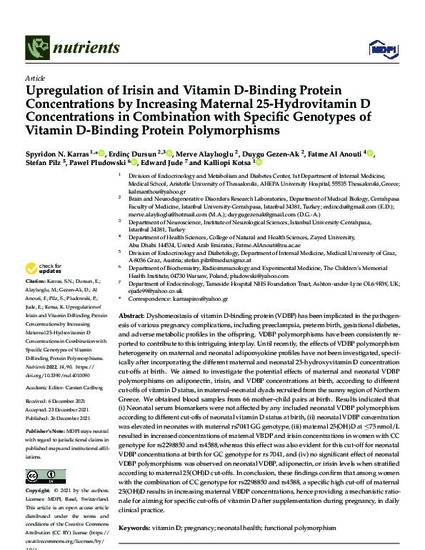
Dyshomeostasis of vitamin D-binding protein (VDBP) has been implicated in the patho-genesis of various pregnancy complications, including preeclampsia, preterm birth, gestational di-abetes, and adverse metabolic profiles in the offspring. VDBP polymorphisms have been consistently reported to contribute to this intriguing interplay. Until recently, the effects of VDBP poly-morphism heterogeneity on maternal and neonatal adipomyokine profiles have not been investi-gated, specifically after incorporating the different maternal and neonatal 25-hydroxyvitamin D concentration cut-offs at birth. We aimed to investigate the potential effects of maternal and neonatal VDBP polymorphisms on adiponectin, irisin, and VDBP concentrations at birth, according to different cut-offs of vitamin D status, in maternal–neonatal dyads recruited from the sunny region of Northern Greece. We obtained blood samples from 66 mother–child pairs at birth. Results indi-cated that (i) Neonatal serum biomarkers were not affected by any included neonatal VDBP poly-morphism according to different cut-offs of neonatal vitamin D status at birth, (ii) neonatal VDBP concentration was elevated in neonates with maternal rs7041 GG genotype, (iii) maternal 25(OH)D at ≤75 nmol/L resulted in increased concentrations of maternal VBDP and irisin concentrations in women with CC genotype for rs2298850 and rs4588,whereas this effect was also evident for this cut-off for neonatal VDBP concentrations at birth for GC genotype for rs 7041, and iv) no significant effect of neonatal VDBP polymorphisms was observed on neonatal VDBP, adiponectin, or irisin levels when stratified according to maternal 25(OH)D cut-offs. In conclusion, these findings confirm that among women with the combination of CC genotype for rs2298850 and rs4588, a specific high cut-off of maternal 25(OH)D results in increasing maternal VBDP concentrations, hence providing a mechanistic rationale for aiming for specific cut-offs of vitamin D after supplementation during pregnancy, in daily clinical practice.
- Functional polymorphism,
- Neonatal health,
- Pregnancy,
- Vitamin D
Available at: http://works.bepress.com/fatme-alanouti/35/
